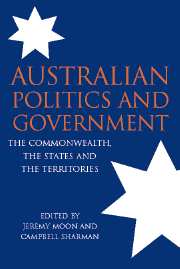Book contents
- Frontmatter
- Contents
- List of contributors
- List of figures and tables
- Acknowledgements
- 1 Introduction
- 2 The Commonwealth
- 3 New South Wales
- 4 Queensland
- 5 South Australia
- 6 Tasmania
- 7 Victoria
- 8 Western Australia
- 9 Australian Capital Territory
- 10 Northern Territory
- 11 One System or Nine?
- Note on Sources and Links to the Web
- Notes
- Appendix: Periods in Office
- References
- Index
8 - Western Australia
Published online by Cambridge University Press: 05 September 2012
- Frontmatter
- Contents
- List of contributors
- List of figures and tables
- Acknowledgements
- 1 Introduction
- 2 The Commonwealth
- 3 New South Wales
- 4 Queensland
- 5 South Australia
- 6 Tasmania
- 7 Victoria
- 8 Western Australia
- 9 Australian Capital Territory
- 10 Northern Territory
- 11 One System or Nine?
- Note on Sources and Links to the Web
- Notes
- Appendix: Periods in Office
- References
- Index
Summary
Western Australia was the last colony to decide to join federation, just as it had been the last to gain self-government. Both of these characteristics can be explained by apprehensions about political representation. Federation in 1901 meant trusting a new and distant national government to safeguard Western Australia's interests in areas of trade and tariffs where the colony was especially vulnerable, and the granting of self-government, some thirty years after the eastern colonies, had been delayed for Western Australia in large part because of the small size of the European population concentrated in the south-west corner of a vast territory.
From its founding, politics in Western Australia has been more strongly shaped by distance and isolation than any other state. This has been as true for politics within the state as it has for relations with the rest of Australia and the wider world. In both political and economic realms, the state has been acutely aware of the costs, and occasional benefits, of separation from the bulk of the nation's population in the south-east of Australia. And within the western third of the continent which comprises Western Australia, more than two-thirds of the state's current population of just under two million lives within a hundred kilometres of Perth. The rest are dispersed in a few moderately sized regional centres and many small farming communities, forestry, mining and fishing enterprises, Aboriginal settlements, and a growing number of communities dependent on tourism. These extend from the cool temperate forests of the south-west, through farming land, scrub and desert to the tropical climates of the north and north-west coast.
- Type
- Chapter
- Information
- Australian Politics and GovernmentThe Commonwealth, the States and the Territories, pp. 183 - 208Publisher: Cambridge University PressPrint publication year: 2003
- 3
- Cited by



